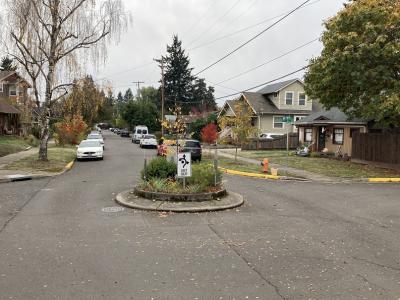Traffic Circle FAQ
Neighborhood traffic circles are raised circular islands constructed in the center of residential street intersections and are used for traffic calming on Neighborhood Bikeways and other low-traffic streets.
Frequently Asked Questions
11th Street and Tyler Avenue is the intersection of two Neighborhood Bikeways, where heavier than usual bike traffic occurs. A traffic circle will facilitate continuous movement for both cyclists and motorists through the intersection while keeping speeds reasonable. It also provides passive traffic control and discourages cut through traffic in the neighborhood.
10th Street and Grant Avenue are both classified as collector streets with marked vehicle, bike, and parking lanes. Collector streets have higher volumes of vehicles traveling through the intersection compared to the intersection of two local streets, such as 11th Street and Tyler Avenue. This intersection, compared to 10th Street and Grant Avenue, shows roughly 1/6th the amount of vehicle throughput, making a traffic circle an appropriate treatment. Neighborhood traffic circles already exist within our community where two local streets intersect, such as at 11th Street and C Avenue.
Traffic circles are effective at reducing crashes at intersections because there are fewer conflict points. They also reduce speeds at the intersection and multiple traffic circles can help reduce speeds along an entire corridor.
- Slow your speed as you approach the intersection. 15mph is ideal.
- Stop in advance of the sidewalk if pedestrians are crossing.
- Yield to vehicles that arrive first at the intersection.
Yield to vehicles on the right if arriving at the same time. - Keep to the right and travel around the traffic circle in a counterclockwise direction.
- Watch for incoming vehicles.
- Wait until traffic yields to you when crossing.
- Do not cross to the middle of the circle.
A traffic circle is similar to an intersection with signals in which you need to signal the direction in which you are going to take. When turning right, you need to signal right, when going straight you do not signal, and when turning left or doing a U-turn you signal left. Whenever you exit a traffic circle you need to signal right to show you are exiting. Cyclists should use hand signals.
Do not stop inside the traffic circle. If you have not yet entered the traffic circle, pull to the right and let the emergency vehicles pass you. If you are in the traffic circle, exit as normal, then pull to the right and let the emergency vehicle pass you.
Yes, the apron of the traffic circle is built with a height so that it can be driven over if need be. It should be done very slowly to prevent damage to the vehicle.
Generally, there are no problems with snow or debris removal in traffic circle.
